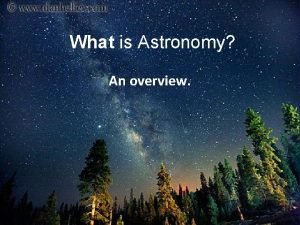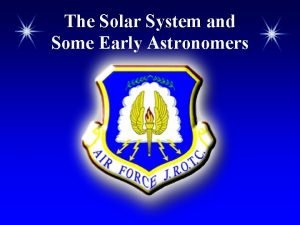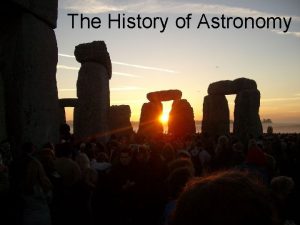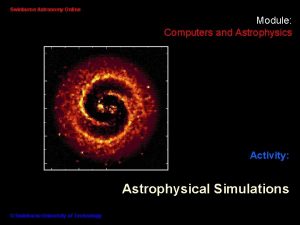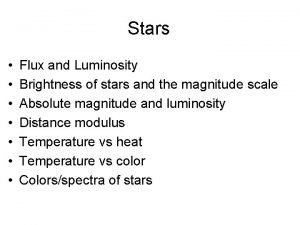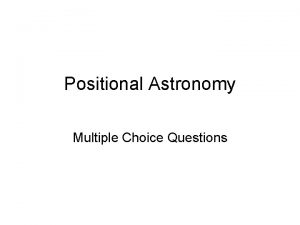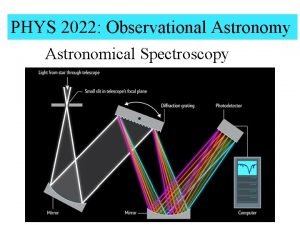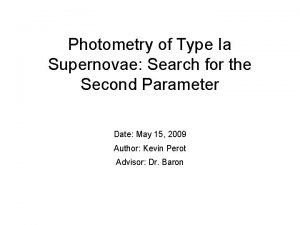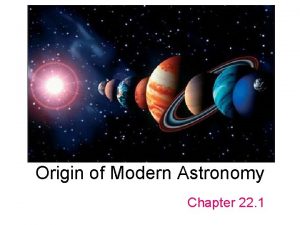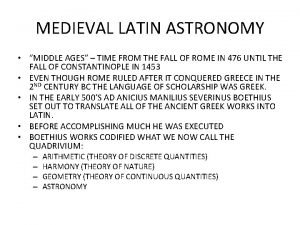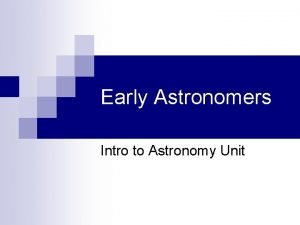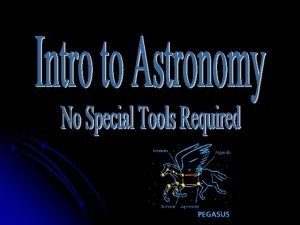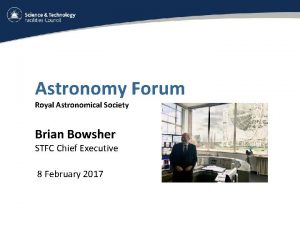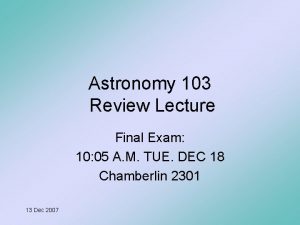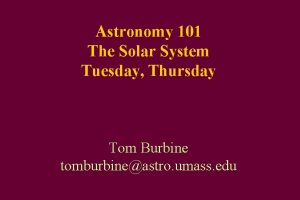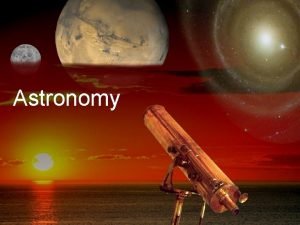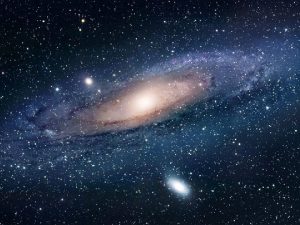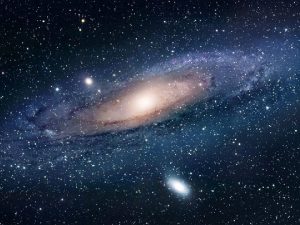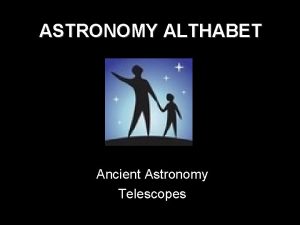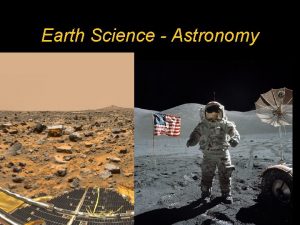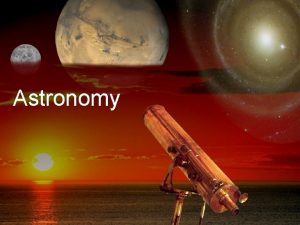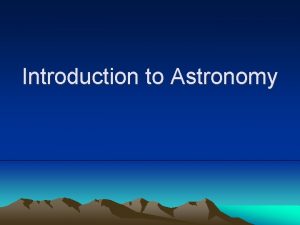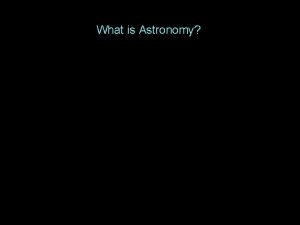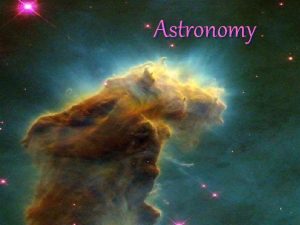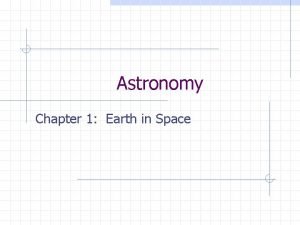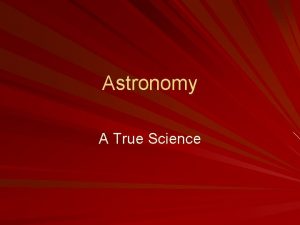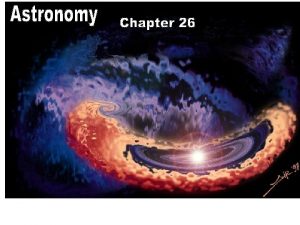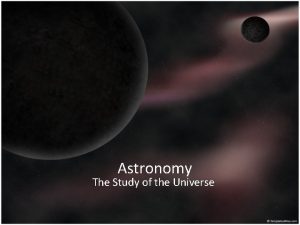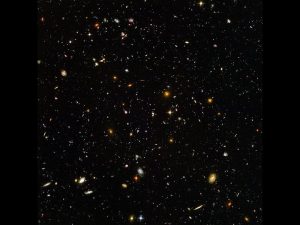Astronomy Elementary Astronomy Astronomy 4 Study of the






































































- Slides: 70

Astronomy Elementary Astronomy

Astronomy 4 Study of the Heavens 4 Science – verifiable predictions 4 Physics (some math)

Finding One’s Way in the Sky 4 Celestial Sphere – imaginary sphere 4 Horizon – line where sky meets ground 4 Zenith – point on celestial sphere directly overhead 4 Meridian – imaginary line running N-S that passes through zenith

Finding One’s Way in the Sky 4 Celestial Poles – projection of Earth’s rotation axis on celestial sphere 4 Celestial Equator – imaginary circle lying halfway between north and south poles – projection of Earth’s equator

Finding One’s Way in the Sky 4 Ecliptic – annual path of the Sun projected on celestial sphere 4 Zodiac – narrow band, around the ecliptic – many of the constellations have animal names – zoo zodiac

Finding One’s Way in the Sky

Finding One’s Way in the Sky 4 Locating Objects – celestial sphere has 2 -d surface – two numbers to locate an object 4 Origin – reference point 4 Units – measuring system

Finding One’s Way in the Sky 4 Linear vs. Angular Measurement – linear distances meaningless on celestial sphere – angular measurements – 360 o in a circle – 60 minutes (`) in one degree – 60 seconds (``) in one minute – 43 o 52`34``

Finding One’s Way in the Sky 4 Earth – Latitude • natural reference points, poles and equator • 90 o N=north pole, 90 o S=south pole, 0 o =equator – Longitude • arbitrary reference point • prime meridian through Greenwich, England = 0 o

Latitude and Longitude

Latitude and Longitude

Finding One’s Way in the Sky 4 Celestial Sphere – need way of measuring angles (compass, sextant, protractor) 4 Two systems for determining position – Altitude-Azimuth – Equatorial

Altitude - Azimuth Coordinates 4 Altitude – angular distance above horizon 4 Azimuth – angular distance measured in CW direction from N* 4 Advantages – very easy to determine 4 Disadvantages – depends on location

Equatorial Coordinates 4 Declination – angular distance from celestial equator – north (+), south (-) celestial poles 90 o 4 Right Ascension – measured in an easterly direction from the location of the vernal equinox 4 Advantages – same for all observers 4 Disadvantages – more difficult to determine

Motion of Heavenly Objects Observations and Explanations

Sun 4 Observation – rises in East, sets in West – daily (diurnal) 4 Explanations – Sun moves through the sky (old) – Earth rotates on axis once per day (accepted)

Sun 4 Observation – moves west to east wrt to stars – yearly (annual)

June 20

July 20

Sun 4 Observation – moves west to east wrt to stars – yearly (annual) 4 Explanation – Earth orbits Sun 4 Ecliptic – apparent path of the Sun through sky

Sun 4 Observation – sunrise and sunset move north and south – hours of daylight increase and decrease – annual 4 Explanation – Earth’s rotation axis is tilted with respect to plane of orbit

Northern Summer Northern Winter Southern Summer

Seasons 4 Northern Hemisphere – summer solstice • rotational axis points toward Sun • most hours of daylight • Sun rises northernmost along eastern horizon – vernal equinox (Spring) • equal hours of day and night • Sun rises directly East • moving north

Seasons 4 Northern Hemisphere – winter solstice • axis points away from Sun • fewest hours of daylight • Sun rises southernmost along eastern horizon – fall equinox • equal hours of day and night • Sun rises directly East • moving south

Seasons and the Celestial Sphere

Keeping Time 4 Solar Day – time between two successive crossings of the meridian by the Sun – 24 hours 4 Sidereal Day – time between two successive crossings of the meridian by a star – 23 hrs 56 min

Day 2 Day 1 difference between sidereal day and solar day: sidereal day is shorter

Keeping Time 4 Tropical Year – time for sun to complete one trip around ecliptic – 365. 242 solar days 4 Sidereal Year – time for constellations to complete one trip around the sky – 365. 256 solar days 4 Difference due to Precession

North Star 4 Observation – different stars play the role of north star – difficult observation to make – time scale of 26, 000 years 4 Explanation – Earth’s rotation axis wobbles – precession

North Star and Precession

North Star

Planets (“wanderers”) 4 Observation – five visible to naked eye • Mercury, Venus, Mars, Jupiter, Saturn – east to west • daily – west to east • move in zodiac (narrow band surrounding ecliptic) – retrograde (east to west)

Planetary Configurations 4 Conjunction – lies in same direction of the sky as the Sun – Superior • Sun between planet and us – Inferior • planet between Sun and us • only occurs for Mercury and Venus

Planetary Configurations 4 Opposition – planet lies directly opposite the Sun in the sky – only occurs for Mars, Jupiter & Saturn Superior Conjunction Inferior Conjunction Earth Opposition

Planetary Configurations 4 Transit – object moves across the Sun’s disk – occurs only for inferior planets 4 Greatest Elongation – greatest angular separation of a planet from Sun – Mercury - 28 o – Venus - 47 o – superior planets - 180 o











Explanations Historical Perspective

Shape of the Earth (Sphere) 4 Pythagoras – sphere is perfect shape 4 Aristotle – change in stars with change in latitude – appearance of ships’ sails – shadow of Earth during lunar eclipse

Size of Earth 4 Erastothenes (276 - 195 B. C. ) – geometry Parallel Light Rays (40, 000 km at equator)

Sun, Earth and Moon 4 Aristarchus – Moon about 1/3 size of Earth – Sun about 20 times farther away than Moon – Sun bigger than Earth – heliocentric theory

Geocentric Theory 4 Earth is center of motion. – Sun, Moon, planets, stars all move around Earth 4 Fast moving objects are near Earth 4 Epicycle (Ptolemy ) – circles on circles – could explain retrograde motion

Heliocentric Theory 4 Copernicus (1473 - 1543) 4 Sun is center of motion – Earth, planets, stars move around Sun in circles 4 explains retrograde motion 4 allows calculation of relative distances 4 Problems: – no parallax observed – predictions were not much better

Tycho Brahe (1546 -1601) 4 superior observations 4 Heavens are changeable – supernova • beyond planets – comet • outside of Earth’s atmosphere 4 compromise – all planets orbit Sun – Sun orbits Earth

Johannes Kepler (1571 - 1630) 4 analysis of Tycho’s data 4 Three Laws of Planetary Motion 1 Planets move in elliptical orbits with the Sun at one focus. 2 Equal areas in equal times. 3 P 2 =k a 3

Law 1 - Ellipse 4 squashed circle 4 eccentricity – measure of flattening – ratio of distance between foci to length of major axis • 0 = perfect circle 4 most orbits have small e semimajor axis

Law 2 - Equal Areas 4 Planets move faster when closer to the Sun

Law 3 - 2 P = 3 ka 4 P is the period of the planet – how long it takes the planet to complete one orbit 4 a is the length of the semimajor axis

Galileo Galilei (1564 - 1642) 4 observed moons of Jupiter – orbiting something other than the Earth 4 phases of Venus – Venus in orbit around Sun 4 Sunspots – Sun is not unchanging 4 Craters on the Moon – ordinary rock

Isaac Newton (1642 - 1727) 4 Laws of Motion 4 Theory of Gravity

Newton’s Laws of Motion

Describing the Motion 4 position – location 4 velocity – speed and direction 4 acceleration – change in velocity • changing speed • changing direction • both changing

Changes in Motion 4 Galileo – rolling on inclines – inertia • tendency of an object at rest to remain at rest and an object in motion to keep moving

Changes in Motion 4 Newton=s First Law of Motion – An object at rest remains at rest. – An object in motion continues to move in a straight line at a constant speed unless a net force acts on it. – Such motion is called "uniform" 4 Non-uniform motion is accelerated motion.

Orbital Motion 4 non-uniform – object follows a curved path – even if speed is constant 4 First Law º a force must act on it – astronomical objects • force is Gravity

Orbital Motion 4 Law of Gravity – described by Newton – F = GMm/r 2 • • M = mass of one object m = mass of the other object r = distance between the two objects G = 6. 7 x 10 -11 N-m 2/kg 2

Newton's Second Law of Motion 4 F = ma – change in motion depends on force – change in motion depends on mass • mass measures amount of material • more technically, its inertia 4 allows shape of orbit and details of motion to be worked out

Newton's Third Law 4 action = reaction 4 the force that the Earth exerts on you is equal in size to the force you exert on the Earth

Measuring a Body's Mass 4 Newton's laws of gravity and motion allow mass of object to be deduced from orbital motion of object moving around it 4 Example using planets 4 example using Galilean satellites

Gravity 4 Surface Gravity – gravitational force of planet on object – this is the weight of object

Gravity 4 Escape Velocity – speed needed to move away from an object and not fall back – depends on gravitational force – higher speed • mass will go higher • escape velocity for Earth = 11 km/s

Gravity 4 Escape Velocity – atmospheres • low escape velocity • high temperature • little atmosphere – black holes • escape velocity exceeds speed of light
 Learning astronomy by doing astronomy activity 1 answers
Learning astronomy by doing astronomy activity 1 answers Learning astronomy by doing astronomy activity 1 answers
Learning astronomy by doing astronomy activity 1 answers Learning astronomy by doing astronomy
Learning astronomy by doing astronomy Hát kết hợp bộ gõ cơ thể
Hát kết hợp bộ gõ cơ thể Lp html
Lp html Bổ thể
Bổ thể Tỉ lệ cơ thể trẻ em
Tỉ lệ cơ thể trẻ em Gấu đi như thế nào
Gấu đi như thế nào Chụp phim tư thế worms-breton
Chụp phim tư thế worms-breton Chúa yêu trần thế
Chúa yêu trần thế Môn thể thao bắt đầu bằng chữ f
Môn thể thao bắt đầu bằng chữ f Thế nào là hệ số cao nhất
Thế nào là hệ số cao nhất Các châu lục và đại dương trên thế giới
Các châu lục và đại dương trên thế giới Công của trọng lực
Công của trọng lực Trời xanh đây là của chúng ta thể thơ
Trời xanh đây là của chúng ta thể thơ Cách giải mật thư tọa độ
Cách giải mật thư tọa độ Làm thế nào để 102-1=99
Làm thế nào để 102-1=99 Phản ứng thế ankan
Phản ứng thế ankan Các châu lục và đại dương trên thế giới
Các châu lục và đại dương trên thế giới Thể thơ truyền thống
Thể thơ truyền thống Quá trình desamine hóa có thể tạo ra
Quá trình desamine hóa có thể tạo ra Một số thể thơ truyền thống
Một số thể thơ truyền thống Bàn tay mà dây bẩn
Bàn tay mà dây bẩn Vẽ hình chiếu vuông góc của vật thể sau
Vẽ hình chiếu vuông góc của vật thể sau Nguyên nhân của sự mỏi cơ sinh 8
Nguyên nhân của sự mỏi cơ sinh 8 đặc điểm cơ thể của người tối cổ
đặc điểm cơ thể của người tối cổ Thế nào là giọng cùng tên? *
Thế nào là giọng cùng tên? * Vẽ hình chiếu đứng bằng cạnh của vật thể
Vẽ hình chiếu đứng bằng cạnh của vật thể Vẽ hình chiếu vuông góc của vật thể sau
Vẽ hình chiếu vuông góc của vật thể sau Thẻ vin
Thẻ vin đại từ thay thế
đại từ thay thế điện thế nghỉ
điện thế nghỉ Tư thế ngồi viết
Tư thế ngồi viết Diễn thế sinh thái là
Diễn thế sinh thái là Các loại đột biến cấu trúc nhiễm sắc thể
Các loại đột biến cấu trúc nhiễm sắc thể Các số nguyên tố
Các số nguyên tố Tư thế ngồi viết
Tư thế ngồi viết Lời thề hippocrates
Lời thề hippocrates Thiếu nhi thế giới liên hoan
Thiếu nhi thế giới liên hoan ưu thế lai là gì
ưu thế lai là gì Khi nào hổ mẹ dạy hổ con săn mồi
Khi nào hổ mẹ dạy hổ con săn mồi Sự nuôi và dạy con của hổ
Sự nuôi và dạy con của hổ Hệ hô hấp
Hệ hô hấp Từ ngữ thể hiện lòng nhân hậu
Từ ngữ thể hiện lòng nhân hậu Thế nào là mạng điện lắp đặt kiểu nổi
Thế nào là mạng điện lắp đặt kiểu nổi Ecological study vs cohort study
Ecological study vs cohort study Retrospective cohort study vs prospective cohort study
Retrospective cohort study vs prospective cohort study Critical examination in method study
Critical examination in method study Marty lobdell
Marty lobdell Phytogeographical zones of india
Phytogeographical zones of india Time study meaning
Time study meaning Distinguish between time study and motion study
Distinguish between time study and motion study What is astronomy
What is astronomy Claudius ptolemy astronomy contributions
Claudius ptolemy astronomy contributions Astronomy greek roots
Astronomy greek roots Swinburne astronomy
Swinburne astronomy Stellar flux
Stellar flux Magnitude flux equation
Magnitude flux equation Clea exercises
Clea exercises Astronomy questions and answers multiple choice
Astronomy questions and answers multiple choice Phys 2022
Phys 2022 Distance ladder astronomy
Distance ladder astronomy Origin of modern astronomy chapter 22
Origin of modern astronomy chapter 22 Astronomy in the middle ages
Astronomy in the middle ages Astronomy definition earth science
Astronomy definition earth science Claudius ptolemy astronomy contributions
Claudius ptolemy astronomy contributions Cuhk astronomy
Cuhk astronomy L
L Astronomy forum uk
Astronomy forum uk Astronomy 103 final exam
Astronomy 103 final exam Astronomy 101 formulas
Astronomy 101 formulas




















































